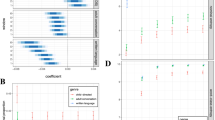Abstract
This research attempts to understand howchildren learn to use language. Instead ofusing syntax-based grammar rules to model thedifferences between children's language andadult language, as has been done in the past, anew model is proposed. In the new researchmodel, children acquire language by listeningto the examples of speech that they hear intheir environment and subsequently use thespeech examples that have been previously heardin similar contextual situations. A computermodel is generated to simulate this new modelof language acquisition. The MALL computerprogram will ‘listen’ to examples of humanspeech, as would occur around a child, and thentry to use these examples in new situationsthat are similar to the contextual situationsin which the language examples were ‘heard’. This will provide a better understanding of howchildren learn to use language and howeducators can assist or improve the languagelearning process by providing required examplesof speech or by helping children to develop abetter understanding of similarities betweenvarious contexts.
Similar content being viewed by others
REFERENCES
Abbott, A. and G. Stiegler: 1996, The View from Europe. Nature 383: 199–200.
Benowitz, N.L.: 1997, Birthing of Clinical Pharmacologists. Clinical Pharmacology and Therapeutics 62: 587–591.
Bergeron, M.G.: 1995, Introduction: Vision of the Future. The American Journal of Medicine 99 (Suppl 6A): 79S–80S.
Borchardt, R.T.: 1997, Are Graduate Programs Training Pharmaceutical Scientists to Function Effectively in the New, Highly Integrated and Globalized Pharmaceutical Industry. Pharmaceutical Research 14: 554–555.
Borchardt, R.T.: 1997, Value of harmaceutical Sciences. Pharmaceutical Research 14: 958–966.
Cockburn, I. and R. Henderson: 1996, Public-private Interaction in Pharmaceutical Research. Proceedings of the National Academy of Sciences 93: 12725–12730.
DeLisi, C. and C. Cantor: 1997, Hedgehogs, Foxes, and a New Science. Nature Biotechnology 15: 819.
Dewhurst, D.G. and C.P. Page: 1998, A survey of the Content of BSc Courses in Pharmacology in UK Universities – Is It Time for a Core Curriculum? Trends in Pharmacological Sciences 19: 262–265.
Dibner, M.D. and C.J. Sollod: 1997, From Bench to Business: Career Opportunities in Biotechnology. Nature Biotechnology 15: 958–960.
Ekins, S. and R.J. McGowan: 2001, The Limits of Reductionism: The Shifting Genomic Paradigm's Impact on Industry and Academia. ILS 10th Interdisciplinary Conference on Science and Culture, Kentucky State University. Philosophy of Science 9: 179–202.
Fletcher, L.: 1996, Ready to Roll Four-year PhD Programmes in Scotland. Research and Funding News from the Wellcome Trust 26.
Flowers, C.R. and K.L. Melmon: 1997, Clinical Investigators as Critical Determinants in Pharmaceutical Innovation. Nature Medicine 3: 136–143.
Horton, B.: 1996, TheWorld of the Postdoc. Nature 383: 195–197.
Jones, I.: 1998, A Start in Life: Student PhD Training Programmes. Research and Funding News from the Wellcome Trust 6.
Kuhlmann, J.: 1997, Drug Research: From the Idea to the Product. International Journal of Clinical Pharmacology and Therapeutics 35: 541–552.
Kuhn, T.: 1996, The Structure of Scientific Revolutions, 3rd edition. University of Chicago Press.
McGowan, G.J. and R.J. McGowan: 1999, Attribution, Cooperation, Science, and Girls. Bulletin of Science, Technology, and Society 19(6): 547–552.
McGowan, M.K. and R.J. McGowan: 1996, Ethics in an MIS Education. Philosophy in the Contemporary World 3(3): 12–17.
Mak, T.W.: 1995, Funding, Education, and Training in the Context of Industryacademia Relations. The American Journal of Medicine 99 (Suppl 6A): 84S–86S.
Marshall, E.: 1996, Hot Property: Biologists Who Compute. Science 272: 1730–1732.
Page, C.P., M.C. Sutter and M.J.A. Walker: 1994, Wither, Whether and Whither Pharmacology. Trends in Pharmacological Sciences 15: 17–19.
Parnham, M.J.: 1994, Moral Challenges in the Organization and Management of Drug Research. Progress in Drug Research 42: 9–37.
Rosenberg, N. and L.E. Birdzall Jr.: 1990, Science, Technology, and the Western Miracle. Scientific American 263(5): 42–54.
Serajuddin, A.T.M.: 1998, Education in Pharmaceutical Sciences Needs a Brand New Direction to Meet the Challenges of Drug Research and Development. Pharmaceutical Research 15: 8–10.
Spilker, B.: 1989, Multinational Drug Companies Issues in Drug Discovery and Development. New York: Raven Press, 499–509.
Wierenga, W.: 1996, Strategic Alliances and the Changing Drug Discovery Process. Pharmaceutical News 3: 13–16.
Wittes, R.E.: 1995, Promoting Synergism in an Era of Change. The American Journal of Medicine 99 (Suppl 6A): 87S–90S.
Zucker, L.G. and M.R. Darby: 1996, Star Scientists and Institutional Transformation; Patterns of Invention and Innovation in the Formation of the Biotechnology Industry. Proceedings of the National Academy of Sciences 93: 12709–12716.
Author information
Authors and Affiliations
Rights and permissions
About this article
Cite this article
Walczak, S. A Context-Based Computational Model of Language Acquisition by Infants and Children. Foundations of Science 7, 393–411 (2002). https://doi.org/10.1023/A:1020721512631
Issue Date:
DOI: https://doi.org/10.1023/A:1020721512631




